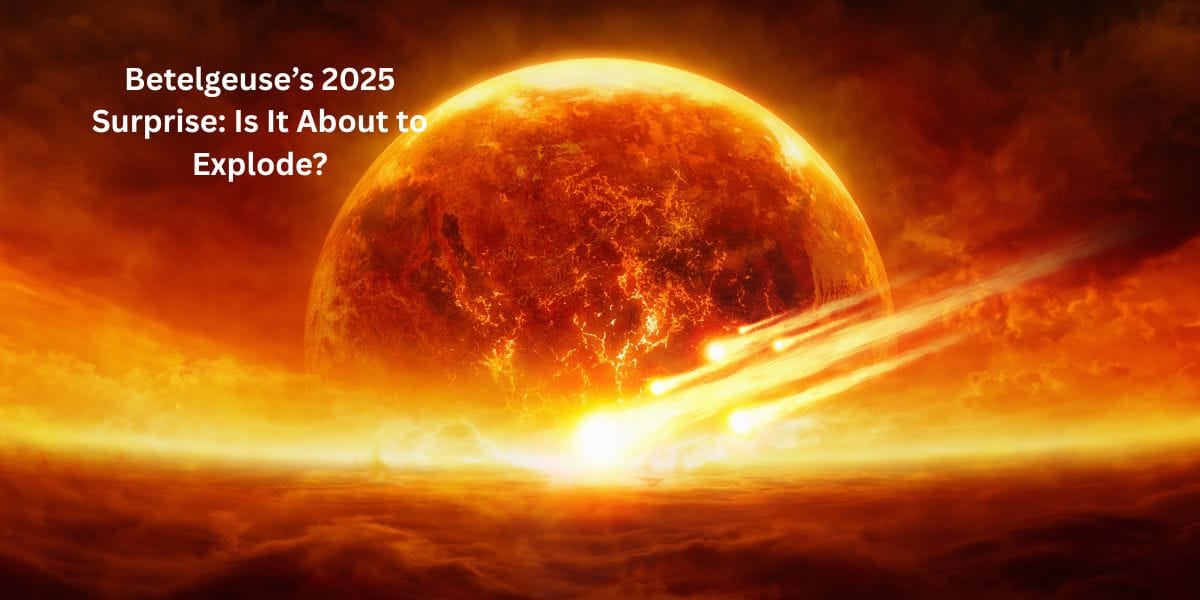Betelgeuse, the bright reddish star in Orion, has been acting strangely for years. Scientists have noticed it dimming and brightening in unusual ways, sparking curiosity about what’s happening. This massive star, one of the most famous in the night sky, could be nearing a dramatic change, but what exactly does that mean?
Betelgeuse is a supergiant star, which means it’s huge and old. Stars like this don’t live forever. Instead, they end their lives in a massive explosion called a supernova. Some experts think Betelgeuse might be close to this big moment. If it explodes, it could shine as bright as the moon for weeks! But the big question is—will Betelgeuse explode in 2025?
What Is Betelgeuse?
Betelgeuse is a red supergiant star in the constellation Orion. It’s one of the biggest stars we know of. If you placed it in our solar system, it would stretch all the way to Jupiter!
- Color: Red-orange
- Distance from Earth: About 642 light-years
- Size: Around 1,000 times bigger than the Sun
Unlike our Sun, Betelgeuse is very old and unstable. It keeps changing in brightness, which makes scientists watch it closely.
Why Is Betelgeuse Acting Strange?
In late 2019, Betelgeuse suddenly became much dimmer. Many people thought it might explode soon. But then, it brightened up again. So, what happened?
Scientists believe Betelgeuse ejected a huge cloud of dust, which blocked some of its light. This made it look dimmer from Earth. The star is also pulsating—meaning it grows and shrinks, changing its brightness.
Fun Fact: Betelgeuse is so big that if it replaced our Sun, its surface would reach between Mars and Jupiter!
Will Betelgeuse Explode in 2025?
This is the big question everyone is asking. The truth is—we don’t know for sure.
Stars like Betelgeuse can live for millions of years, but their final days are unpredictable. It could explode tomorrow, in 100 years, or even later. Scientists say there’s no clear sign that 2025 will be the year.
However, if it does explode, it will be a once-in-a-lifetime event. The explosion would be visible even during the day!
What Happens If Betelgeuse Explodes?
A Betelgeuse supernova would be spectacular but safe for Earth. Here’s what would happen:
- Bright Light: It could shine as brightly as the Moon for weeks.
- No Danger: Since it’s 642 light-years away, the explosion won’t harm us.
- New Nebula: After the explosion, it would leave behind a glowing cloud called a nebula.
Fun Fact: The last supernova seen in our galaxy was in 1604!
How Can You Spot Betelgeuse in the Sky?
Betelgeuse is easy to find if you know where to look.
- Find Orion: Look for three stars in a row (Orion’s Belt).
- Look Up and Left: Betelgeuse is the bright red star above the belt.
It’s best seen in winter, but you can check it out any time Orion is visible.
Should We Expect a Supernova Soon?
Betelgeuse is definitely a star to watch. While it might not explode in 2025, it’s still one of the most fascinating objects in the sky. If it does go supernova, it will be an unforgettable cosmic show.
So, keep looking up—you never know when the universe might surprise us!
How far is Betelgeuse from Earth?
Betelgeuse is about 642 light-years away. That means the light we see today left the star 642 years ago!
Will Betelgeuse’s explosion affect Earth?
No, it’s too far away to harm us. We’ll just see a bright light in the sky.
What color is Betelgeuse?
Betelgeuse is a deep red-orange color because it’s a cool, aging star.
How big is Betelgeuse compared to the Sun?
Betelgeuse is about 1,000 times larger than the Sun. If it replaced our Sun, it would swallow Mercury, Venus, Earth, and Mars!
Has Betelgeuse exploded already?
Since it’s 642 light-years away, if Betelgeuse exploded today, we wouldn’t see it until the year 2667!
Why did Betelgeuse get dimmer in 2019?
Scientists think it released a dust cloud that blocked some of its light temporarily.
Can a supernova destroy planets?
Yes, but only planets very close to the star. Earth is safe from Betelgeuse’s explosion.
How long will Betelgeuse’s supernova be visible?
If it explodes, it could shine brightly for weeks or even months before fading.
Is Betelgeuse the biggest star?
No, but it’s one of the largest known stars. UY Scuti is currently the biggest known star.
When was the last supernova seen from Earth?
The last supernova in our galaxy was observed in 1604. A Betelgeuse explosion would be the next big one!
